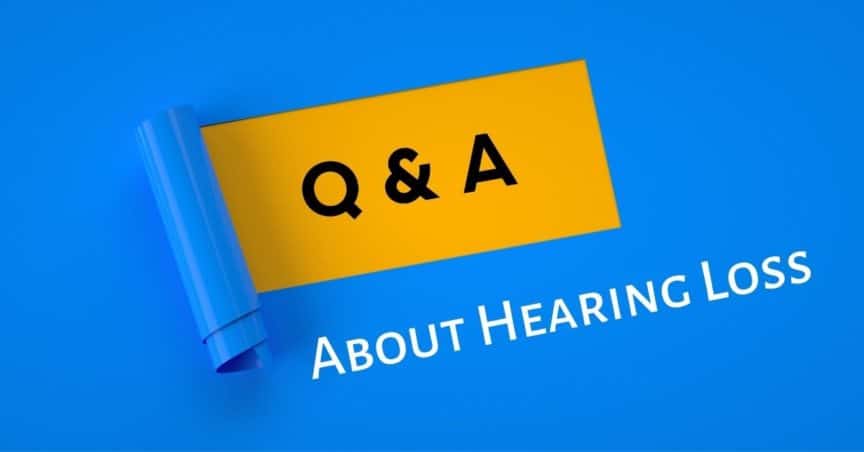- How to Care for Infants With Hearing Loss - April 15, 2024
- Hearing Aid Tips for Runners - April 5, 2024
- Overcoming Misconceptions Around Hearing Aids - March 27, 2024
Though hearing loss is one of the most common chronic conditions that people navigate in the U.S., it is often underdiagnosed. According to the National Institute on Deafness and Other Communication Disorders (NIDCD), nearly 29 million adults could benefit from using hearing aids. There are numerous misconceptions about hearing loss that prevent people from addressing the symptoms they may be experiencing. By answering frequently asked questions, we hope to provide important information that encourages people to prioritize their hearing health!
What causes hearing loss?
There are a variety of factors that can contribute to the development of hearing loss. The most common causes include:
- Existing medical conditions: such as cardiovascular disease, diabetes, stroke, and hypertension which impact blood flow, create inflammation, obstruct arteries etc.; increase the risk of hearing loss
- Aging: age related hearing loss, also known as presbycusis, is another common cause. It results from the natural aging process and/or the increased risk of developing medical conditions that older adults experience.
- Environmental exposure to loud noise: one time and/or consistent exposure to loud noise can damage the hair cells in the inner ear causing hearing loss. Common ways people absorb potentially harmful levels of noise are in the workplace, by listening to audio devices, and being in entertainment venues.
Other causes of hearing loss are head injuries, genetic history, medications, and viral infections.
Doesn’t hearing loss only affect older people?
This is a pervasive myth about hearing loss! Anyone – of any age – can be impacted by hearing loss. According to the NIDCD:
- 1 in 8 people (ages 12 and older) have some degree of hearing loss in the U.S.
- Globally, over 43 million people 12-35 years old live with disabling hearing loss
- 15% of adults (18 and older) report some trouble hearing
Additionally, young adults are becoming more at risk. According to the World Health Organization (WHO):
- 1.1 billion teens and young adults worldwide are high risk due to unsafe use of audio devices and exposure to loud noise in entertainment venues
Older adults do experience a higher risk but other age groups are also impacted by hearing loss!
What are the symptoms?
Hearing loss produces a range of symptoms that can be experienced mildly to profoundly. Common symptoms include:
- Tinnitus: a buzzing, ringing, clicking like noise in one or both ears
- Increasing the volume on electronic devices (TV, speaker, phone)
- Frequently asking others to speak loudly, slowly, and/or repeat themselves
- Difficulty following conversations as words are unclear and seem slurred or muffled
- Struggling to hear, especially in environments with background noise
- Moving to quieter area to have a conversation
- Reading mouths to help identify words
These symptoms strain communication which has far reaching effects on other aspects of life.
Are both ears the same?
Both ears are not the same! You can experience hearing loss in one ear and not the other, or different degrees of hearing loss in both ears. This means that your hearing ability can be different for your ears. Hearing tests measure your capacity in both ears to identify the specific degree of hearing loss in each ear.
Is hearing loss curable?
Hearing loss is a permanent medical condition which means that it is not curable. Typically, hearing loss is caused by damaged hair cells in the inner ear. These hair cells, unlike other types of cells, do not regenerate. Humans are born with all the hair cells we will ever have – thousands in each ear. These hair cells help the brain translate soundwaves into signals that can be processed and understood. There are no medical interventions or treatments that can replenish or treat these hair cells.
Fortunately, there are effective ways hearing loss is treated. The most common treatment is hearing aids which are electronic devices that are designed to absorb, amplify, and process sound. This significantly increases a person’s ability to hear.
Are hearing aids really necessary?
Yes! Hearing aids help maximize hearing in all environments. Not only does this help a person navigate, but it is beneficial to overall health. Wearing hearing aids decreases the risk of cognitive decline, accidental injuries, and unemployment. Additionally, hearing aids allow people to participate fully in daily life, enhancing wellness!

